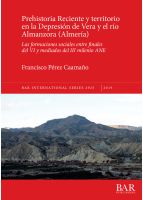Description
El libro propone, basado en el materialismo histórico, la existencia y desarrollo de un modo de producción comunal como funcionamiento básico entre las formaciones sociales que poblaron el territorio de la Depresión de Vera y la Cuenca del río Almanzora (Almería) entre finales del VI y mediados del III milenio ANE. El modo de producción comunal se combinó con una organización social tribal para extenderse sobre el territorio. La reproducción social se organizó a partir de comunidades domésticas donde las relaciones parentales regulaban la fuerza de trabajo y el acceso al producto a partir de una reciprocidad generalizada que mantenía como norma básica la igualdad en la participación en el trabajo y el acceso a lo producido. Sin embargo, la progresiva fragmentación del sujeto colectivo generará una extensión de la fuerza de trabajo donde la reciprocidad irá pasando de generalizada a negativa, restringida cada vez más a grupos domésticos organizados a partir de lo que denominamos unidades territoriales A comienzos del III milenio ANE los mecanismos de fragmentación social parecen iniciar un colapso y algunas comunidades domésticas parecen desarrollarse por encima de otras, con lo que la degradación del modo de producción comunal se hace evidente, y con ella la conflictividad social.
This book, with a theoretical grounding in historical materialism, proposes the existence and development of a communal mode of production as a basic element of the social structures of the groups populating the territory of la Depresión de Vera and la Cuenca del río Almanzora (Almería) between the end of the 6th and the middle of the 3rd millennium BCE. This mode of production, combined with a tribal social organisation, extended itself over the territory. Cultural reproduction was organised through domestic communities in which parental relationships regulated the labour force and access to products via a generalised reciprocity. This ensured, as a basic rule, equality of participation in work and access to what that work produced. However, the progressive fragmentation of the collective subject would generate an extension of the labour force, in which that reciprocity would turn from generalised to negative, and increasingly be restricted to domestic groups organised into what we would call territorial units. At the beginning of the 3rd millennium BCE, social fragmentation mechanisms seem to initiate a collapse and some domestic communities seem to develop over and above others, so that the degradation of the communal mode of production becomes evident, together with accompanying social unrest.
AUTHOR
Francisco Pérez Caamaño es Doctor en Prehistoria por la Universidad de La Laguna y está especializado en Arqueología del Territorio entre las formaciones sociales prehistóricas del SE de la Península Ibérica. En Canarias ha llevado a cabo proyectos arqueológicos relacionados con el análisis del territorio arqueológico de las formaciones sociales aborígenes de las islas de Tenerife y La Palma.
Francisco Pérez Caamaño holds a PhD in Prehistory from La Laguna University. He specialises in territorial archaeology as applied to the prehistoric development of social structures in the southeast of the Iberian Peninsula. He has carried out archaeological projects in the Canary Islands, mostly relating to the archaeological territory analysis of the development of aboriginal social structures in the islands of Tenerife and La Palma.
REVIEW
‘[This] is the first systematic and in-depth analysis of settlement patterns using GIS in an area of the utmost importance for our understanding of Iberian Prehistory. … The results of the analyses are truly new and original, and they constitute a good contribution to Iberian Prehistoric archaeology.’ Dr Víctor Jiménez Jáimez, Universidad de Málaga
‘The quality of the data handled in the work is enormous. … [The author] demonstrates a good management of the theoretical bases associated with historical materialism, especially as it affects the concept of archaeological territory. … The theoretical apparatus of the work is broad and solid.’ Prof. Gabriel García Atiénzar, Universidad de Alicante
‘An enormous, original and interesting work. … It is also worth mentioning the … concise and elegant style, as well as the indisputable mastery of the bibliography produced on the prehistoric archaeology of the southeast of the Iberian Peninsula over the last 150 years.’ Peer reviewer











